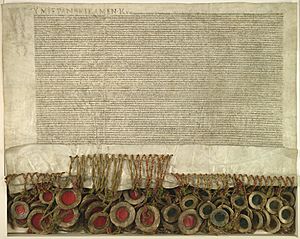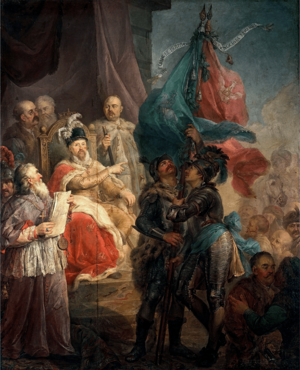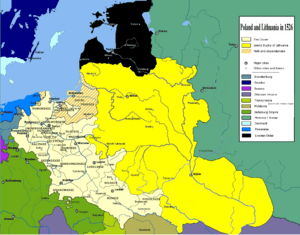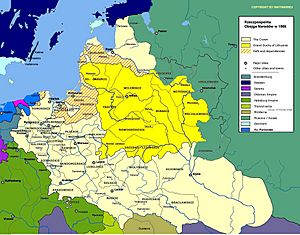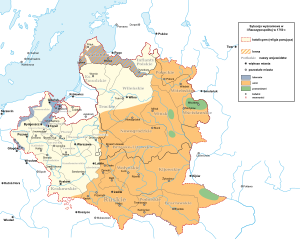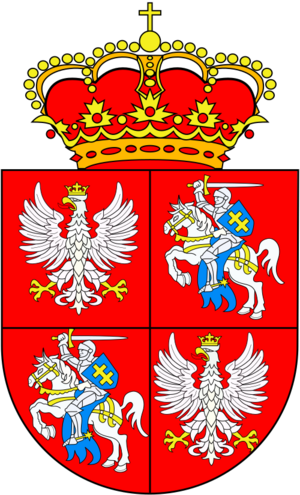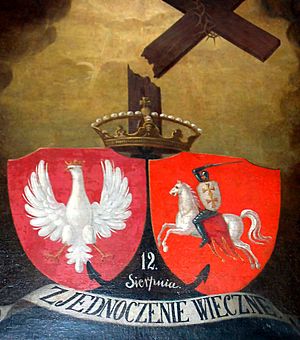Union of Lublin facts for kids
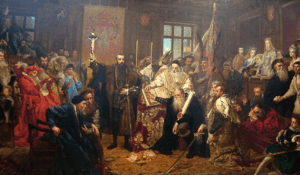
The Union of Lublin (Polish: Unia lubelska; Lithuanian: Liublino unija) was signed on July 1, 1569. This important agreement happened in Lublin, Poland. It created a single, large country called the Polish–Lithuanian Commonwealth. This new country was one of the biggest in Europe at that time.
Before this, Poland and Lithuania were connected by a "personal union." This meant they shared the same ruler, but were still separate countries. The Union of Lublin changed this to a "real union." This made them one country with a shared government. It also created an elective monarchy. This meant that kings would be chosen by election, not just inherited. This was important because King Sigismund II Augustus, the last of the Jagiellons family, had no children. The union helped make sure the country would continue after him.
The Commonwealth had one elected ruler. This person was both the King of Poland and the Grand Duke of Lithuania. They ruled with a shared Senate and parliament called the Sejm. Many people see the Union as a natural step in the long friendship between Poland and Lithuania. It was also needed because Lithuania was in danger from wars with Russia.
Contents
History of the Union
Why the Union Happened
There were many talks before the Union treaty was signed. Powerful Lithuanian nobles, called magnates, worried they would lose their power. They feared their legal status would become the same as the Polish lower nobility, who were much more numerous.
Lithuania was struggling in wars against Russia. By the mid-1500s, it faced a big threat of losing the Livonian War. This could have led to Russia taking over Lithuania.
On the other hand, Polish nobles (the szlachta) didn't want to help Lithuania without getting something back. A lot of Poland's taxes in the 1560s went to support Lithuania's war with Moscow. Polish and Lithuanian leaders also became closer through working together in the military.
King Sigismund II Augustus saw the danger to Lithuania and Poland. He strongly pushed for the union. He slowly gained more support. He even forced landowners who opposed the change of territory from Lithuania to Poland to agree. A big reason for Sigismund was that he was the last of his family, the Jagiellons. He had no children to take over the throne. So, the Union was a way to keep his family's work going. It also helped set up a formal elective monarchy for both countries.
The Sejm Meeting of 1569
The Sejm (parliament) met in January 1569. The meeting took place near the Polish town of Lublin. However, they couldn't agree at first. One big problem was whether Poles could settle and own land in Lithuania.
Most of the Lithuanian group left Lublin on March 1. They were led by Mikołaj "Rudy" Radziwiłł. King Sigismund reacted by adding several regions to Poland on June 6. These regions were Podlachie, Volhynian, Bracław, and Kiev. These lands were a large part of Lithuania's territory. The local nobles in these areas were happy to join Poland. They wanted the economic and political chances Poland offered.
The Lithuanians had to return to the Sejm. They were now led by Jan Hieronimowicz Chodkiewicz. They continued talks, using different methods. The Polish nobles wanted Lithuania to become fully part of Poland. But the Lithuanians still wanted a federal state, where both parts kept some independence. On June 28, 1569, all disagreements were finally solved. On July 4, the King signed the official act at Lublin Castle.
Changes and Outcomes
Cultural Changes
After the Union, Lithuanian nobles had the same rights as Polish nobles. They could rule their lands and people. However, moving up in politics in the mostly Catholic Commonwealth was different.
By the late 1400s, the Polish language was already becoming popular among Lithuanian and Rus' nobles. The Lublin Union sped up this process, called Polonization. In culture and daily life, Polish language and Catholicism became very important for the Ruthenian nobility. Most of them originally spoke Ruthenian and followed the Eastern Orthodox religion.
However, common people, especially farmers, kept speaking their own languages. After the Union of Brest, many converted to Eastern Catholicism. This created a big difference between the lower classes and the nobles in the Lithuanian and Ruthenian areas. Some Ruthenian nobles, like the Ostrogskis, tried to resist Polonization. They stayed Orthodox and gave money to Orthodox churches and schools. But it became harder to resist with each new generation. Eventually, almost all Ruthenian nobles became Polonized.
Economic Changes
The Union led to Polish people settling in Ruthenian lands. It also led to more farmers becoming tied to the land, a system called enserfment. Even though conditions for farmers in the Commonwealth were tough, they had more freedom than farmers in Russia. Because of this, many farmers, nobles, and merchants escaped from Russia to the Commonwealth. This was a big problem for the Russian government.
A shared coin, the złoty, was also introduced.
Geographical Changes
The Union created one of the largest and most populated countries in Europe in the 1600s. Only the Russian and Ottoman Empires were larger.
As part of the Union, Lithuania gave up several regions to Poland. These included Podlaskie, Volhynia, Podolia, and Kiev.
Legal Changes
The laws of Lithuania, called the Statutes of Lithuania, said that any Union laws that went against them were not valid. These differences between Polish and Lithuanian laws lasted for many years. The Third Statute of Lithuania stayed in use in Lithuania even after the country was divided up in the late 1700s, until 1840.
Military Changes
Poland gave military help in wars after the union. This was very important for Lithuania's survival. Poland and Lithuania kept separate armies, but they had common defense plans.
Political Changes
The Union of Lublin brought the two states together. However, each kept a lot of independence. They had their own armies, money, laws, and government offices. Even though they were supposed to be equal, Poland became the stronger partner because it was larger.
There was one ruler for both Poland and Lithuania. This ruler was chosen by the nobles of both nations. They were crowned as King of Poland and Grand Duke of Lithuania in Wawel Cathedral in Kraków.
The shared parliament, the Sejm, met in Warsaw. It had 114 representatives from Poland and 48 from Lithuania. The Senate had 113 Polish senators and 27 Lithuanian senators.
Poland and Lithuania also had a common foreign policy. This meant they worked together on how they dealt with other countries.
Legacy of the Union
The Union of Lublin was a very important achievement for King Sigismund. It created a huge country that lasted over 200 years. However, Sigismund didn't manage to make all the changes needed for a strong political system. He wanted to make the king's power stronger with the help of the lower nobles. He also wanted to balance the power of the lower nobles and the powerful magnates.
But even though all nobles were supposed to be equal by law, the magnates kept a lot of political power. They could often bribe or force the lower nobles to do what they wanted. Also, the king's power kept getting weaker. While nearby countries became strong, centralized monarchies, the Commonwealth fell into a state of "political anarchy." This meant there was a lot of disorder in the government. This disorder eventually led to the country being divided up by its neighbors.
Today, the Republic of Poland sees itself as a country that followed the Polish–Lithuanian Commonwealth. However, the Republic of Lithuania, between the World Wars, often saw the creation of the Commonwealth in a negative way.
The original document of the Union of Lublin was added to the UNESCO Memory of the World Register in 2017.
The Lublin Triangle, a group of countries including Poland, Lithuania, and Ukraine, was named after the Union of Lublin.
See also
 In Spanish: Unión de Lublin para niños
In Spanish: Unión de Lublin para niños
- Union of Kėdainiai
- Union of Lublin Mound


